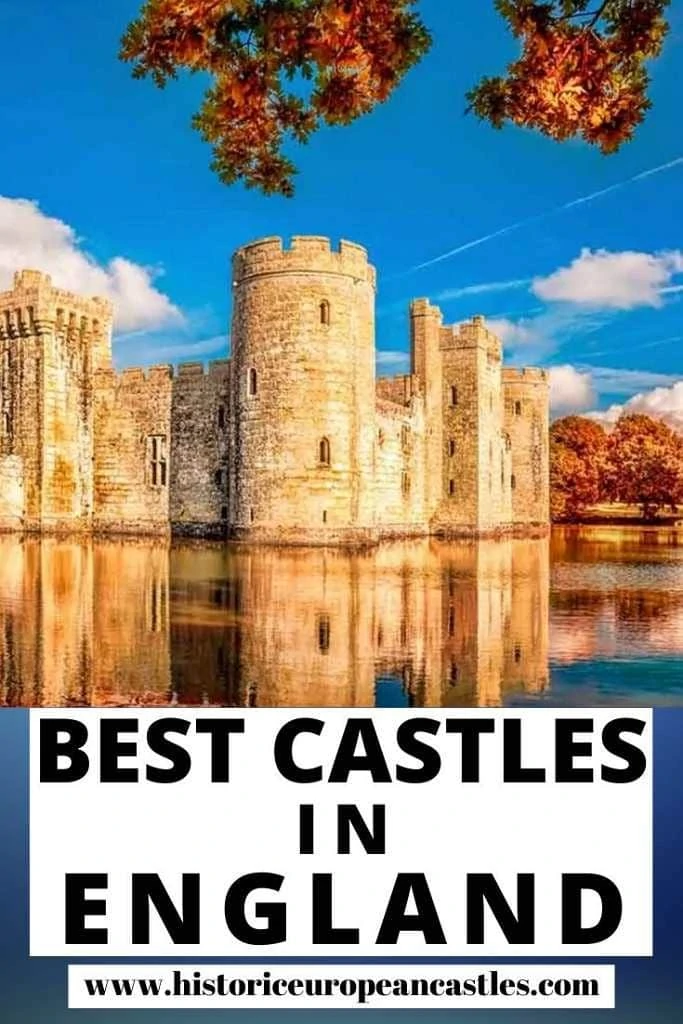Where better to immerse yourself in the rich and often bloody history of England than at one of its many castles. Walk in the footsteps of royalty as you climb towers, view the lavish rooms, walk the ramparts, and enjoy the gardens and grounds whilst learning more about the history of England from Medieval times through the Tudor and Elizabethan times to modern history. With so many castles and grand country homes to visit the only questions is, which one will you visit first?

40 Famous English Castles To Visit
1. Dover Castle
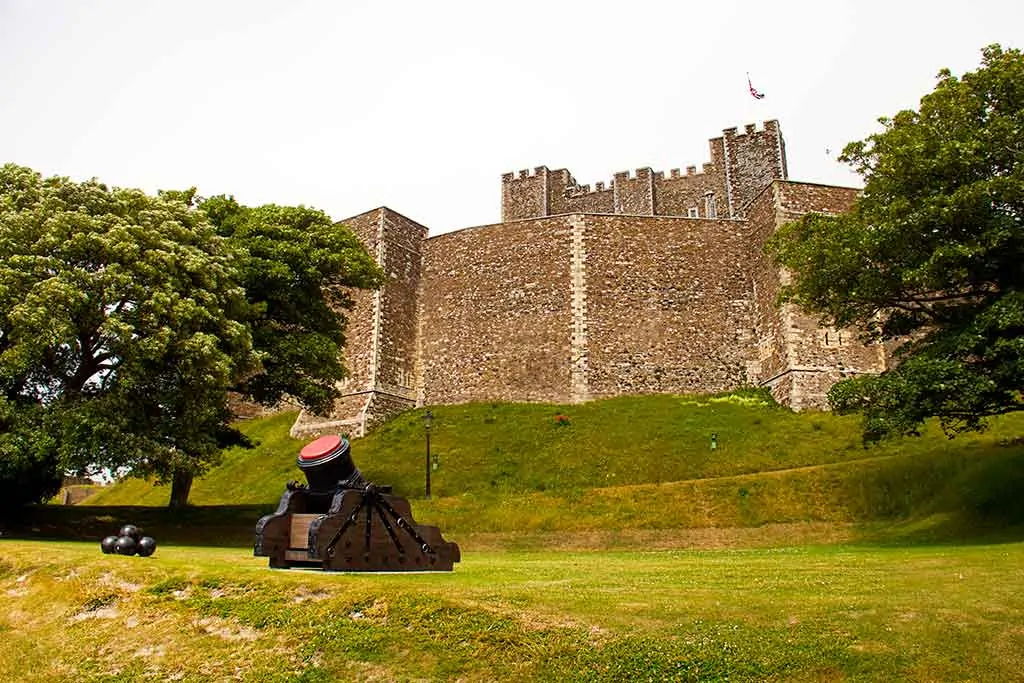
Known as ‘The Key to England’ due to its location next to the White Cliffs of Dover, this iconic Medieval castle is the largest in England. Discover 9 centuries of history as you explore the Great Tower, the underground hospital, the secret wartime tunnels, and more.
Where: Kent
When: 11th century
Style: Medieval
Open for visit: Yes. – Check the English Heritage website for details.
2. Warwick Castle
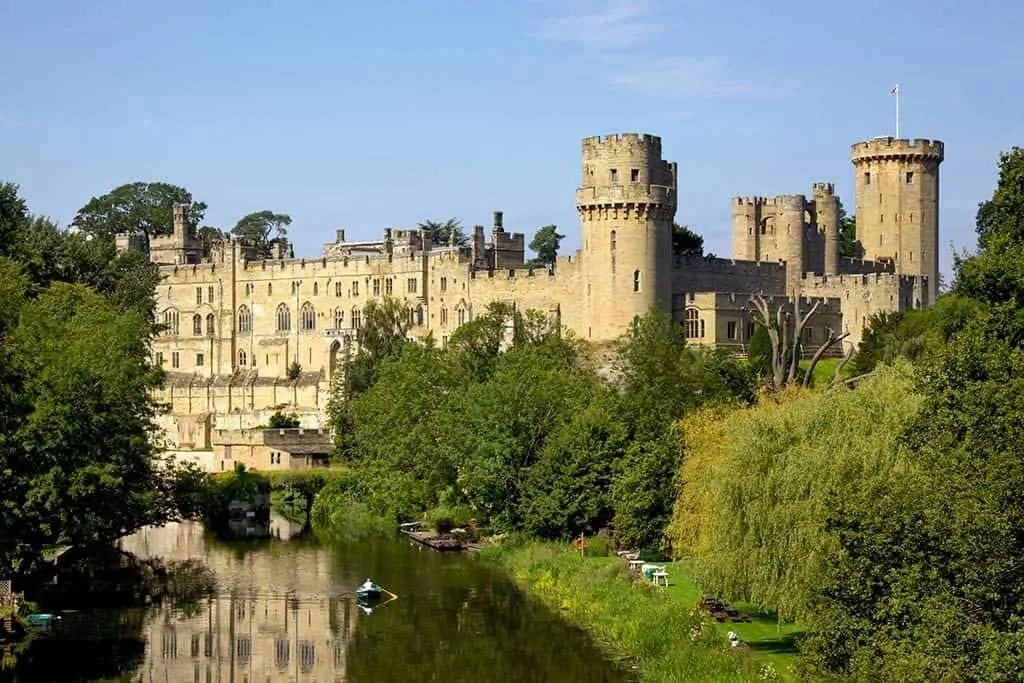
William the Conqueror built Warwick Castle in 1068, replacing the original wooden motte and bailey fort that originally stood on the site. Located on the picturesque River Avon, the castle, one of the best in Europe, provides 1,000 years of history to uncover as you climb the ramparts and the towers before going below ground to the dungeons.
Where: Warwickshire
When: 12th century
Style: Medieval
Open for visit: Yes. Check here for more information.
3. Bodiam Castle
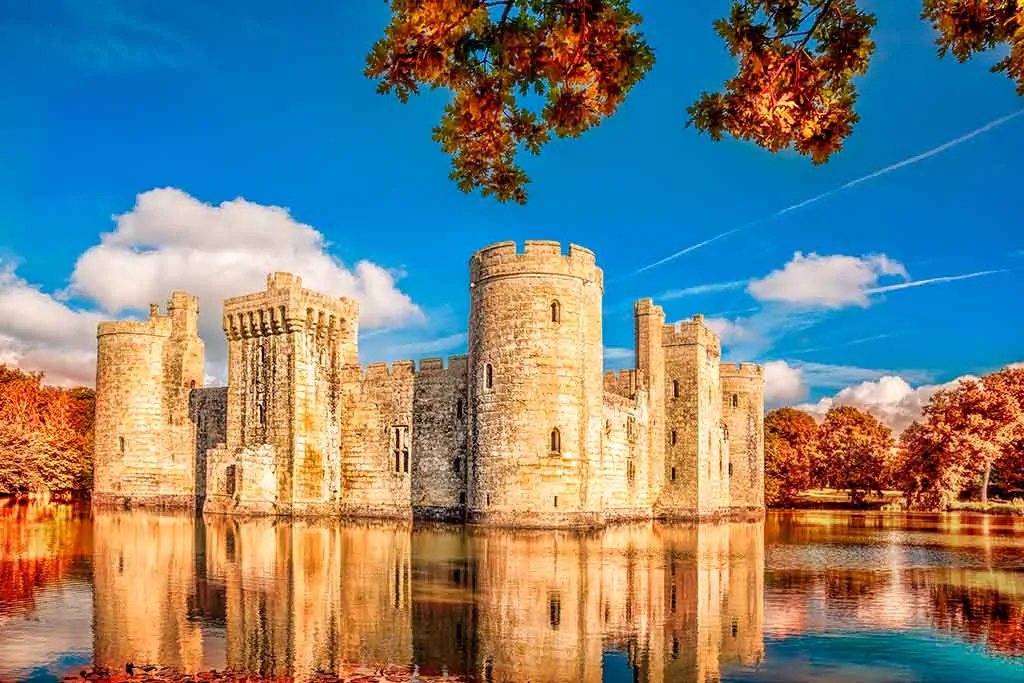
This medieval moated castle is a sight to behold as you learn the history of the castle from Saxon times to the present day. Bodiam Castle is mostly in ruin so you can’t visit any lavish interior rooms but you can soak up the scenic views from the battlements and enjoy the fairytale architecture reflected in the water.
Where: East Sussex
When: 14th century
Style: Medieval
Open for visit: Yes, check here for more information.
Check here some amazing castles to stay in England.
4. Leeds Castle

Set in 500 acres of stunning parkland, this 900-year-old castle is located in Kent close to the village of Leeds rather than the city of Leeds so be sure you’re planning a trip to the right area of England! Originally a Norman stronghold, Leeds Castle later became a royal palace owned by King Henry VIII and Catherine of Aragon.
Where: Kent
When: 12th century
Style: Norman
Open for visit: Yes. Check here for more information.
5. Alnwick Castle
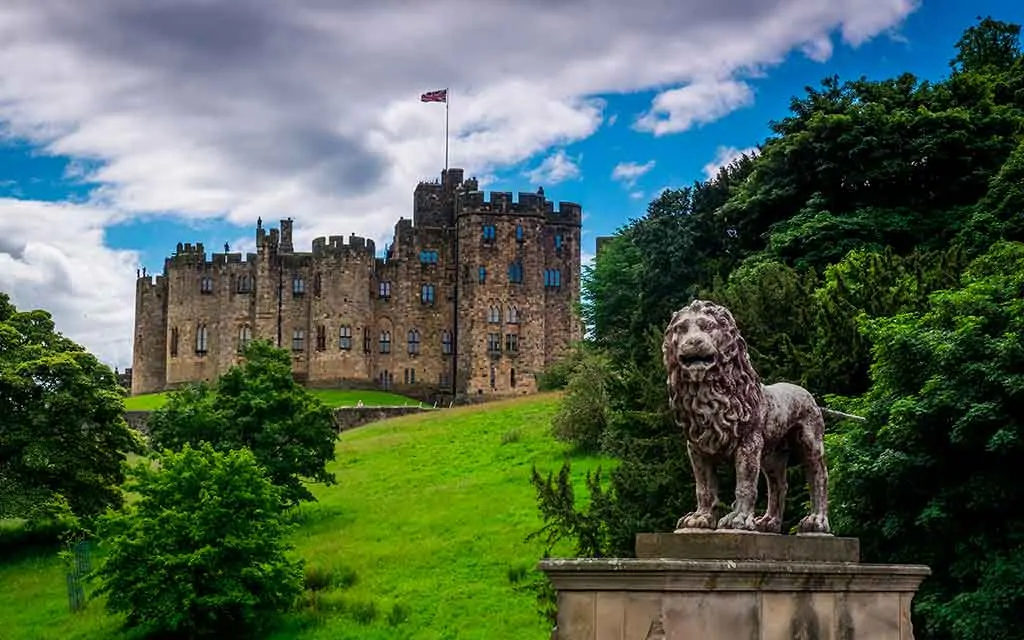
Built after the Norman Conquest, Alnwick Castle is the 2nd largest inhabited castle in England. It has served many purposes over its time from a military outpost to teaching college, family home to the Percy Family, and film set for 2 of the Harry Potter films as well as the set for 2 Christmas Specials of Downton Abbey.
Where: Northumberland
When: 11th century
Style: Norman
Open for visit: Yes. Check here for more information.
6. Bamburgh Castle
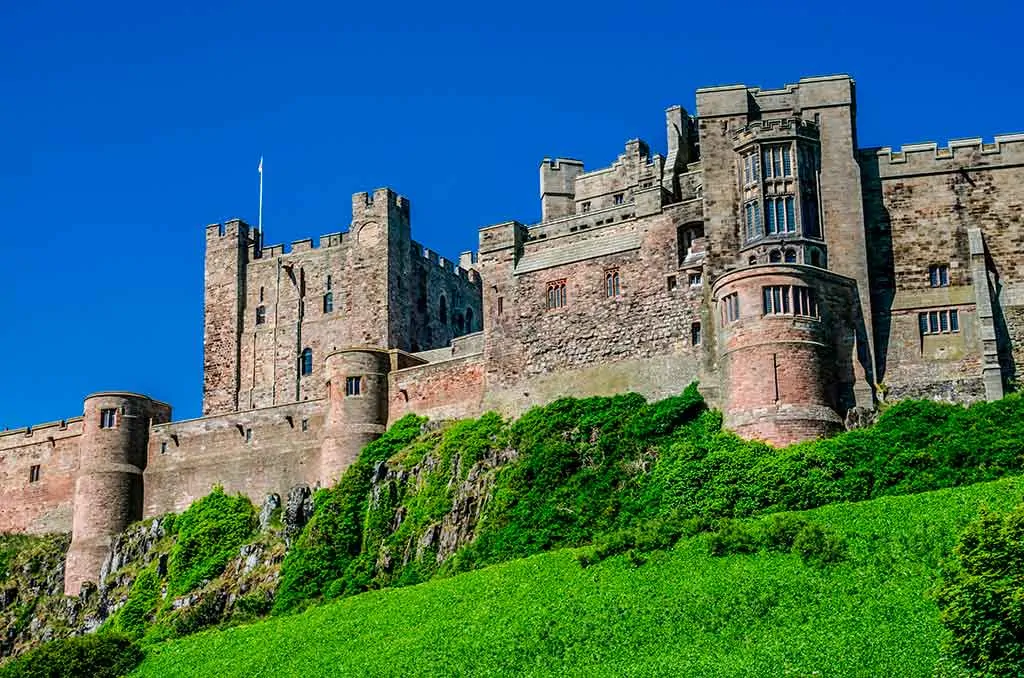
Legends come to life at ‘The King Of Castles’, the once Royal Seat of the Kings of Northumberland that is now Armstrong’s family home. Located on the coast, Bamburgh Castle is a sight to behold viewed from the beach at sunset with plenty of history to be uncovered within its walls.
Where: Northumberland
When: 11th century
Style: Norman
Open for visit: Yes. Check here for more information.
7. Rochester Castle
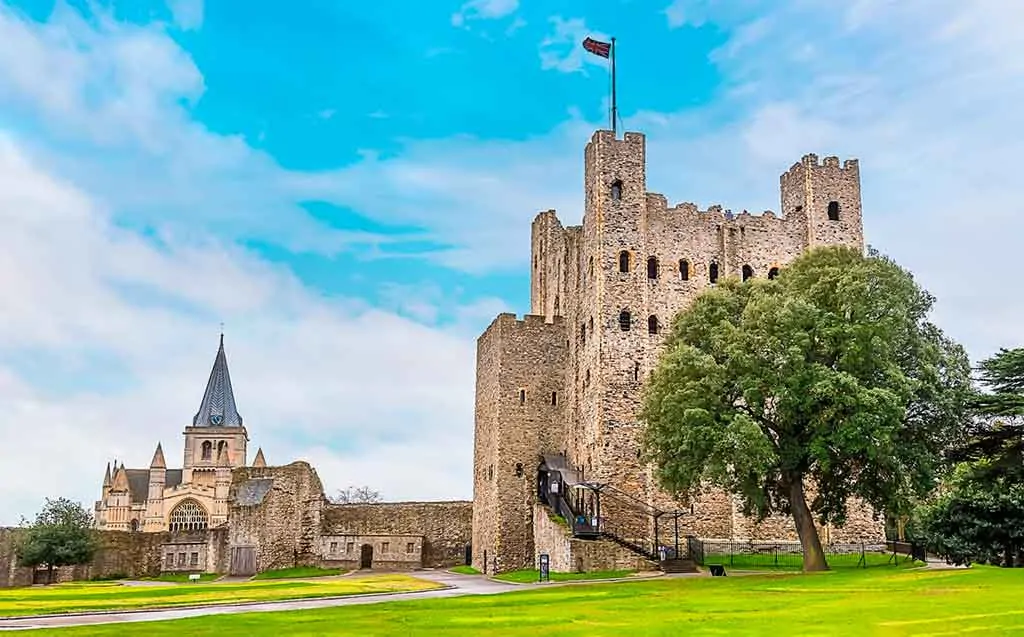
See one of the tallest and best-preserved Norman keeps in England at the fortress of Rochester Castle in Kent. It sits on the sight of an old Roman Settlement on the banks of the River Medway and is an imposing sight visible for miles with a history that starts with Henry I.
Where: Kent
When: 12th century
Style: Norman
Open for visit: Yes, check here for more information.
8. Warkworth Castle
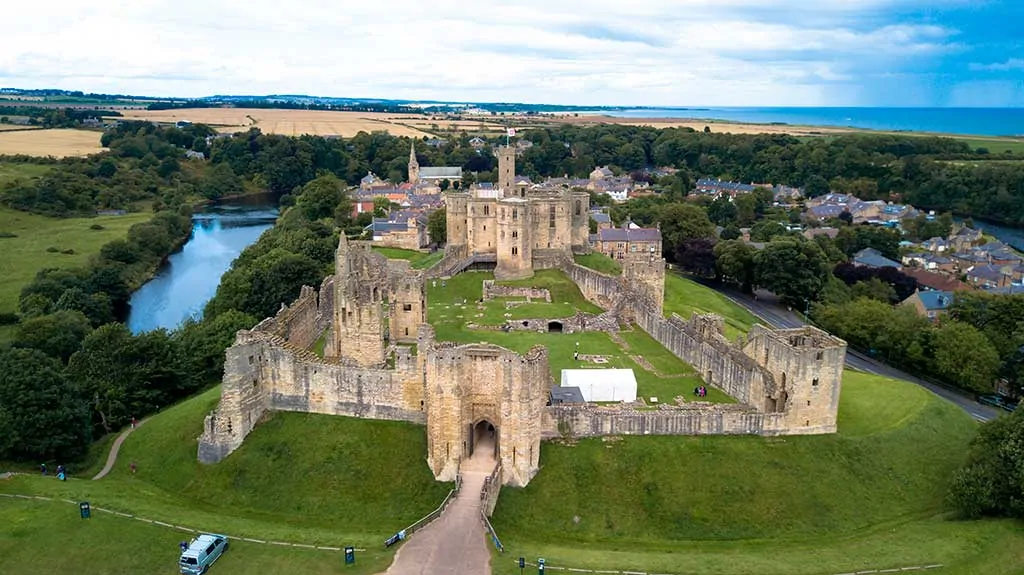
Marvel at the exterior walls of this ruined Medieval Castle and Hermitage that sits on a hilltop with the charming River Coquet running below. The cross-shaped keep is a sight to behold as you explore the Dukes’ rooms learning about the Percy Family who fell foul of King Henry IV after helping to oust Richard II.
Where: Northumberland
When: 12th century
Style: Medieval
Open for visit: Yes. You can check the exact dates on the English Heritage website.
9. Dunstanburgh Castle
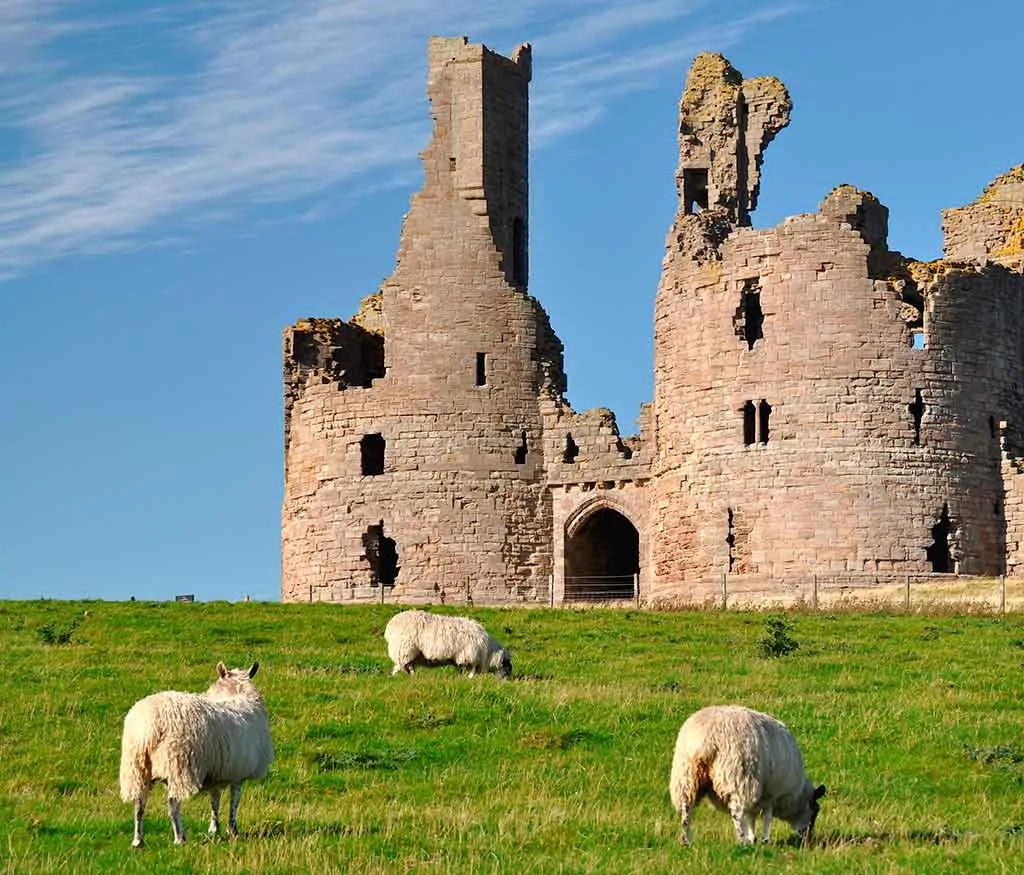
This atmospheric ruined castle, located on the wild Northumberland coastline, played its part in the War of the Roses when it became a Lancastrian stronghold before falling into disrepair. But that’s not where it’s story ended, Dunstanburgh later becomes an observation post during WWII when it found itself open to a potential German invasion.
Where: Northumberland
When: 14th century
Style: Medieval
Open for visit: Yes. Check here for more information.
You might also want to check these posts for castles around England:
- The best castles near Bristol
- The best castles in Cornwall
- The best castles near Brighton
- The best castles near Bath
- The best castles near Manchester
- The best castles near Birmingham
- The best castles in South England
- The best castles to visit in Southeast England
- Best castles in Norfolk
- The best castles in Gloucestershire
- The best castles in Staffordshire
- The best castles in Lake District
- The best castles in Herefordshire
- The best castles in the Cotswolds
10. Lincoln Castle

Home to an original 1215 Magna Carta as well as a 1217 Charter of the Forest, Lincoln Castle is a unique castle having two mottes plus a Victorian prison allowing you to step back in time and walk in the footsteps of both Kings and convicts.
Where: Lincolnshire
When: 11th century
Style: Norman
Open for visit: Yes. Check here for more information.
Click here for the best castles in Lincolnshire.
11. Carisbrooke Castle
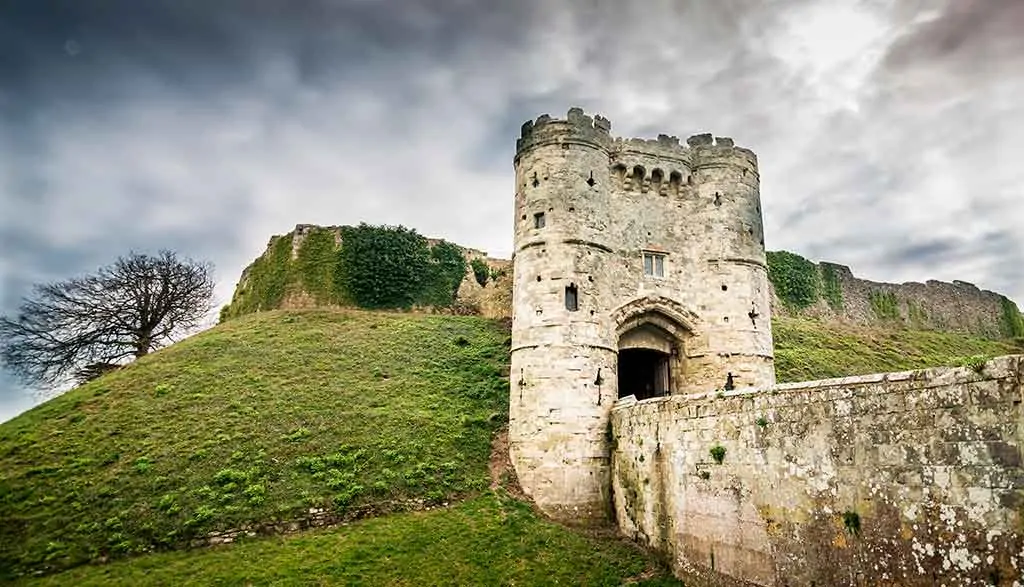
This picturesque motte and bailey castle with its panoramic views and beautiful garden is famous for its donkeys who can still be seen drawing up water from the well today. The castle has had many uses over time including an Elizabethan artillery fortress, a Royal summer residence, and was also used as a prison to hold King Charles I.
Where: Isle of Wight
When: 12th century
Style: Norman & Edwardian
Open for visit: Yes – Check the English Heritage site for details.
12. Lindisfarne Castle
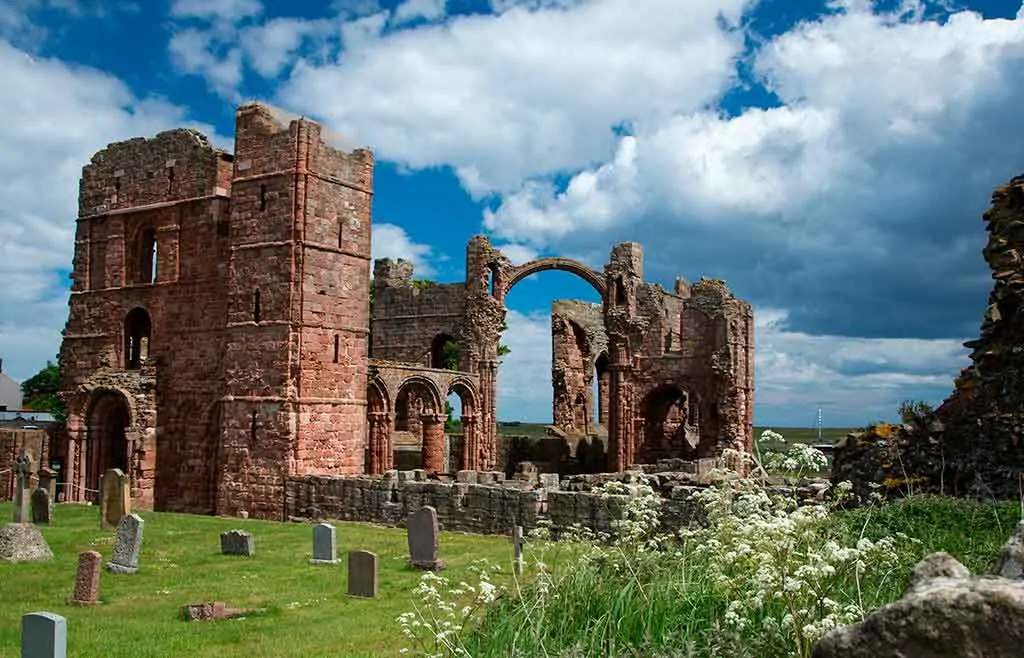
Make a note of the tide times as you cross the causeway to reach Holy Island and uncover the previously untold stories of a castle that’s not really a castle! Raided by the Vikings and later the Scots, the island has a rich history with the castle being built for King Henry after the priory was dissolved with later modifications during the reign of Elizabeth I.
Where: Holy Island
When: 16th century
Style: Elizabethan
Open for visit: Yes. Tide times should be checked for safe crossings. Closed in Winter. Check here for more information.
13. Raby Castle
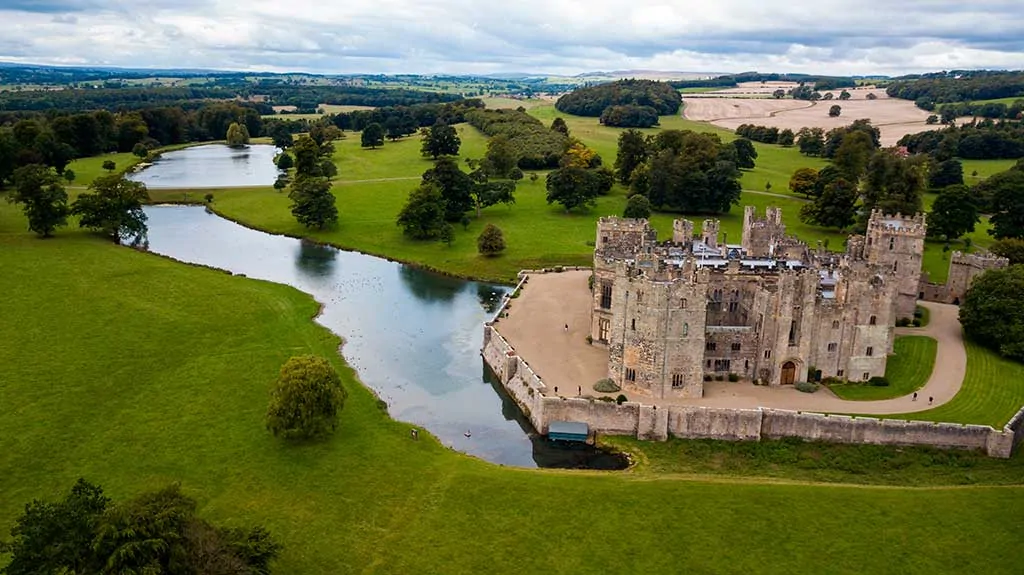
Surrounded by 200 acres of parkland containing herds of wild red and fallow deer, Raby Castle is one of the grandest and best-preserved Medieval castles in North East England. Take a guided tour around the lavish interior rooms, home to the 12th Lord Barnard, before admiring the 18th-century ornamental walled garden.
Where: County Durham
When: 14th century
Style: Medieval
Open for visit: Yes. Check here for more information.
14. Durham Castle

This 900+-year-old castle is unique in that it has been occupied by University College, part of Durham University, since 1840 and is, therefore, the home of more than 100 students hence castle access is only permitted to visitors who book a guided tour.
Where: County Durham
When: 14th century
Style: Norman
Open for visit: Yes, guided tours usually take place 3-4 times daily. Check here for more information.
15. Carlisle Castle

Due to its location close to the border, this Medieval fortress has played a key role in defense in the English/Scottish wars and invasions. It was at Carlisle Castle where Mary, Queen of Scots was held captive by Queen Elizabeth I and was also occupied by Bonnie Prince Charlie.
Where: Cumbria
When: 11th century
Style: Medieval
Open for visit: Yes. Check here for more information.
Check out some more interesting castles in Cumbria.
16. Lewes Castle
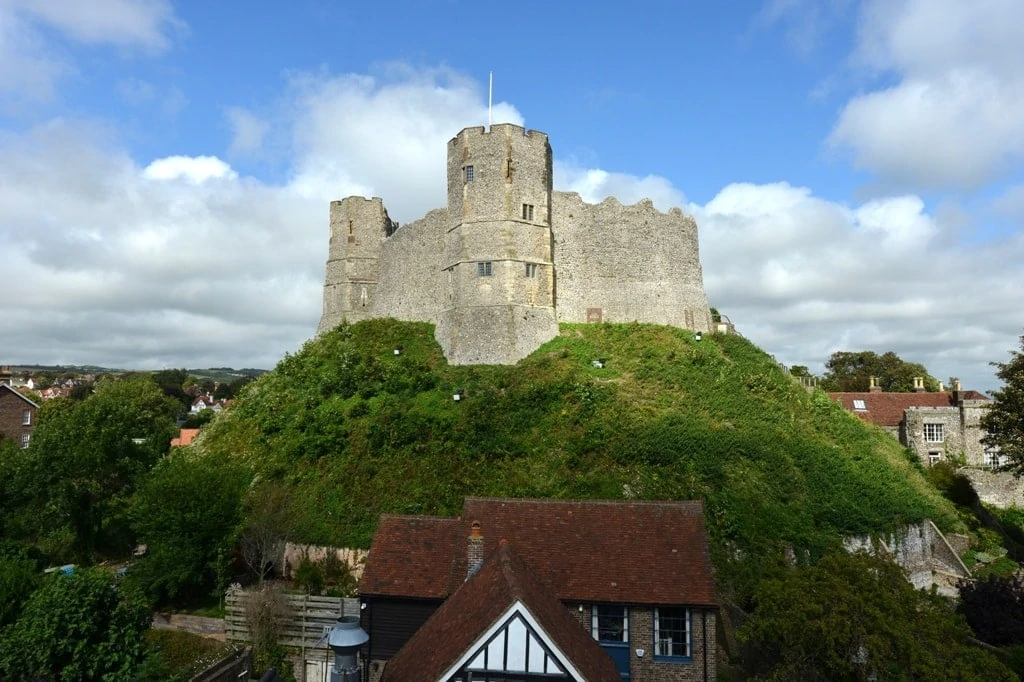
Originally called Bray Castle, this Norman motte and bailey castle with 2 mottes was built to control a piece of the Sussex coast that was left unprotected. It offers stunning views of the Sussex countryside from its towers as you discover the 1,000-year history of this castle that was used as a prison as well as a warehouse.
Where: Sussex
When: 12th century
Style: Norman
Open for visit: Yes. Check here for more information.
17. Lancaster Castle
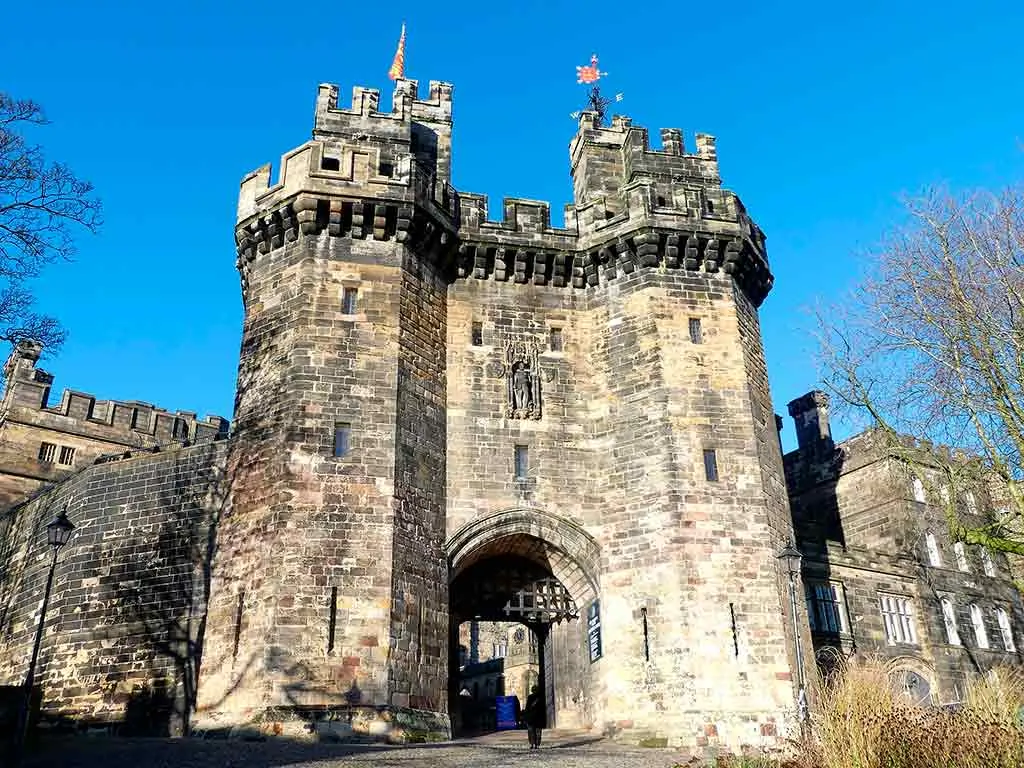
With a history spanning back to Roman times, Lancaster Castle (otherwise known as John O’ Gaunt’s Castle) is described as ‘the North-West’s most important historic and archaeological monument’. It was here that the trials of the Lancaster witches took place and until 2011 was used as a prison!
Where: Lancashire
When: 11th century
Style: Medieval
Open for visit: Yes. Check here for more information.
18. Colchester Castle
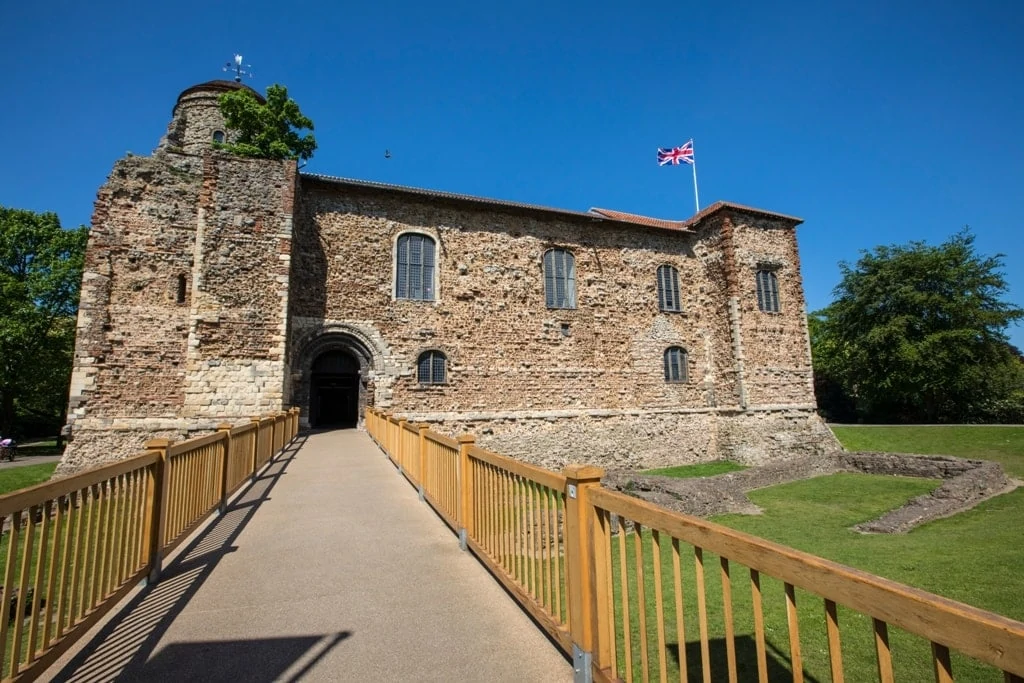
Boasting the largest Norman keep in Europe, the interior of this castle doesn’t feature lavishly furnished rooms as you might expect, instead it’s a museum where you’ll find an array of interactive displays alongside exhibits that showcase the history of Colchester. You can also take a guided tour down into the vaults or up onto the castle roof.
Where: Essex
When: 11th century
Style: Norman
Open for visit: Yes. Check here for more information.
19. Oxford Castle
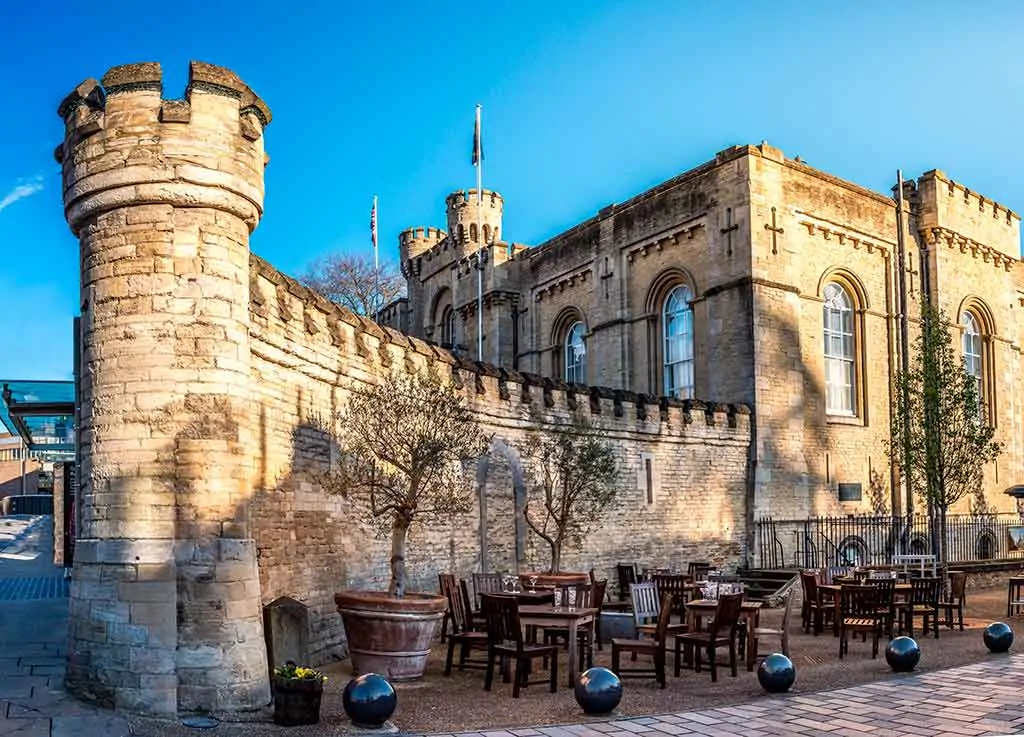
Uncover 1,000 years of history as you enjoy a guided tour of the partially ruined Oxford Castle led by a costumed tour guide before getting the chance to explore the other side of the castle, Oxford Prison which was active until 1996, at your own pace.
Where: Oxfordshire
When: 12th century
Style: Norman
Open for visit: Yes, Oxford castle is guided tour only. Check here for more information.
20. Canterbury Castle
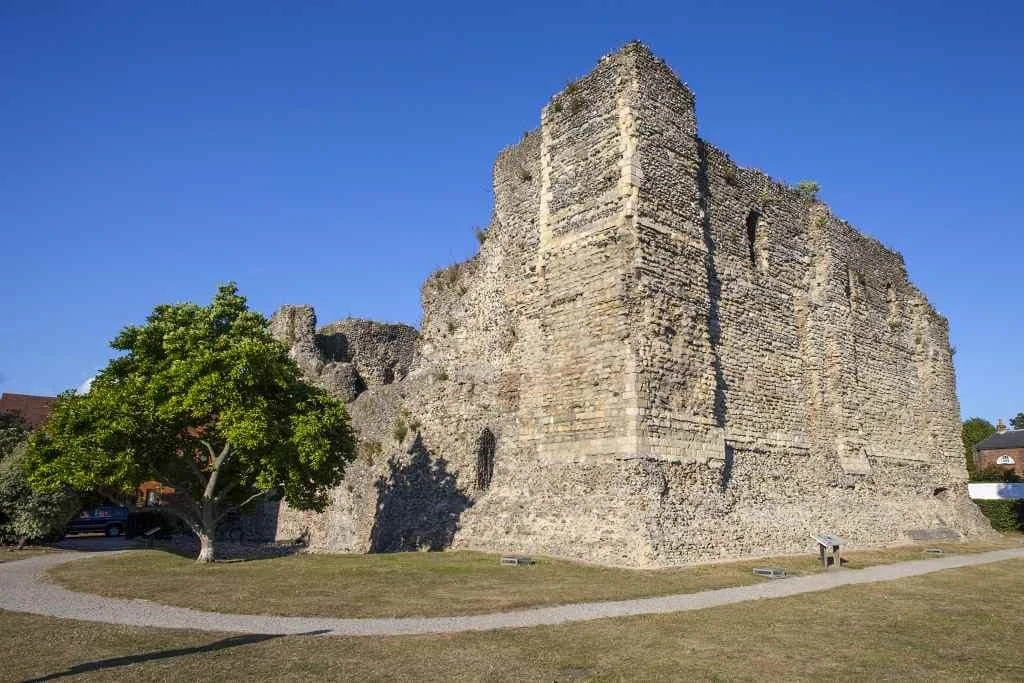
One of the earliest Norman castles in the area, the outer walls of the Norman keep and Westgate is the most prominent features that still remain of the ruined Canterbury Castle. Fans of architecture and history will enjoy a walk around the exterior but otherwise, there’s not much to see/do here.
Where: Kent
When: 14th Century
Style: Norman Ruins
Open for visit: Westgate can be visited but the castle grounds are currently closed.
21. Castle Drogo
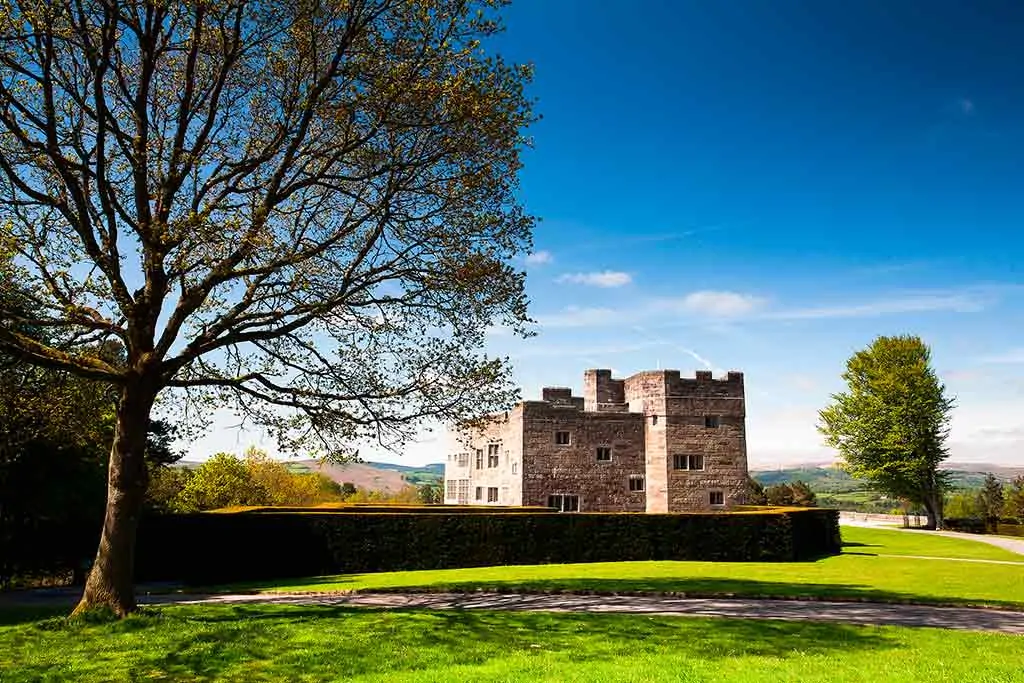
The last castle to be built in England, Castle Drogo is a dramatic country house overlooking the woodlands of the Teign Gorge and our across Dartmoor. Enjoy walks through the garden before heading inside to see the 14 rooms with tapestries and other items on display that tell the story of the Drewe family.
Where: Devon
When: 20th century
Style: Medieval and Tudor
Open for visit: Yes. Check here for more information.
Check out the best castle in Devon.
22. Belvoir Castle
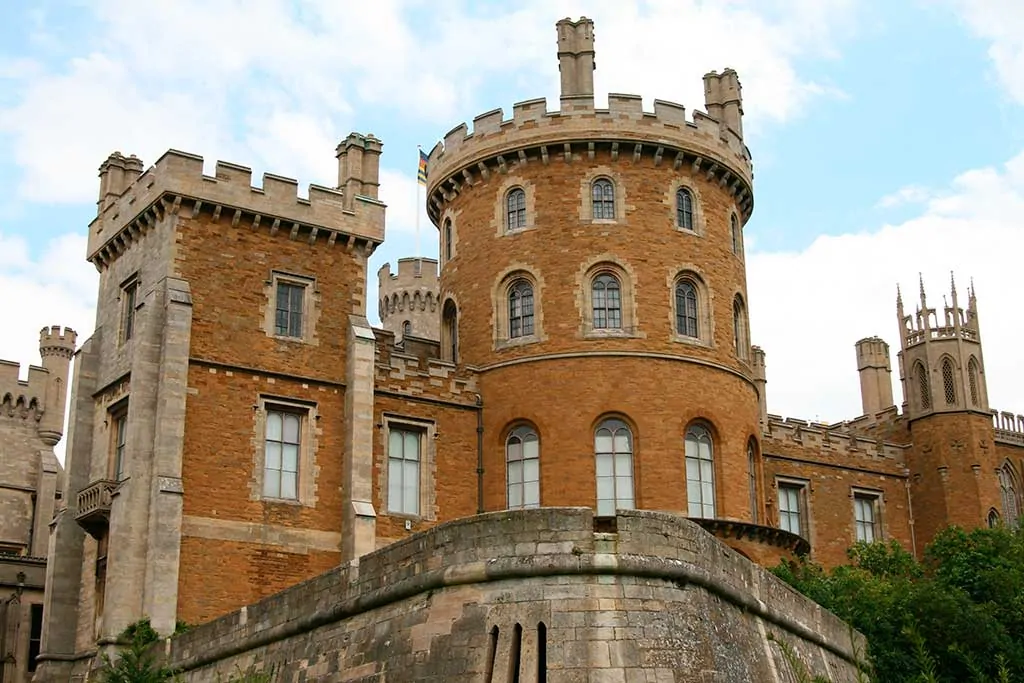
This stately home set within 16,000 acres of land boats some of the finest Regency architecture in the world and is the home of the Duke of Rutland and his family.
Take a guided tour of the staterooms with the option to also see the private quarters before exploring the estate with its formal gardens, lakes, woodland trails, and more.
Where: Leicestershire
When: 19th century
Style: Regency
Open for visit: Open on selected dates from March to October. See Belvoir Castle website for exact opening times.
23. Ripley Castle

This country house with deer land park and the walled garden is located on the edge of the Yorkshire Dales National Park ensuring some wonderful views. 6 rooms of the house can be visited on a guided tour as you follow 700 years of family history.
Where: Yorkshire
When: 14th century
Style: Gothic
Open for visit: Yes, by guided tour only. Check here for more information.
Check out the best castles in Yorkshire.
24. Totnes Castle

This stunning motte and bailey castle has only its curtain wall still standing but is very much a sight to behold with the beautiful views across the Saxon town rooftops to the River Dart. The perfect place for a picnic and kids to let off steam.
Where: Devon
When: 14th century
Style: Norman
Open for visit: Yes. Check here for more information.
25. Tattershall Castle
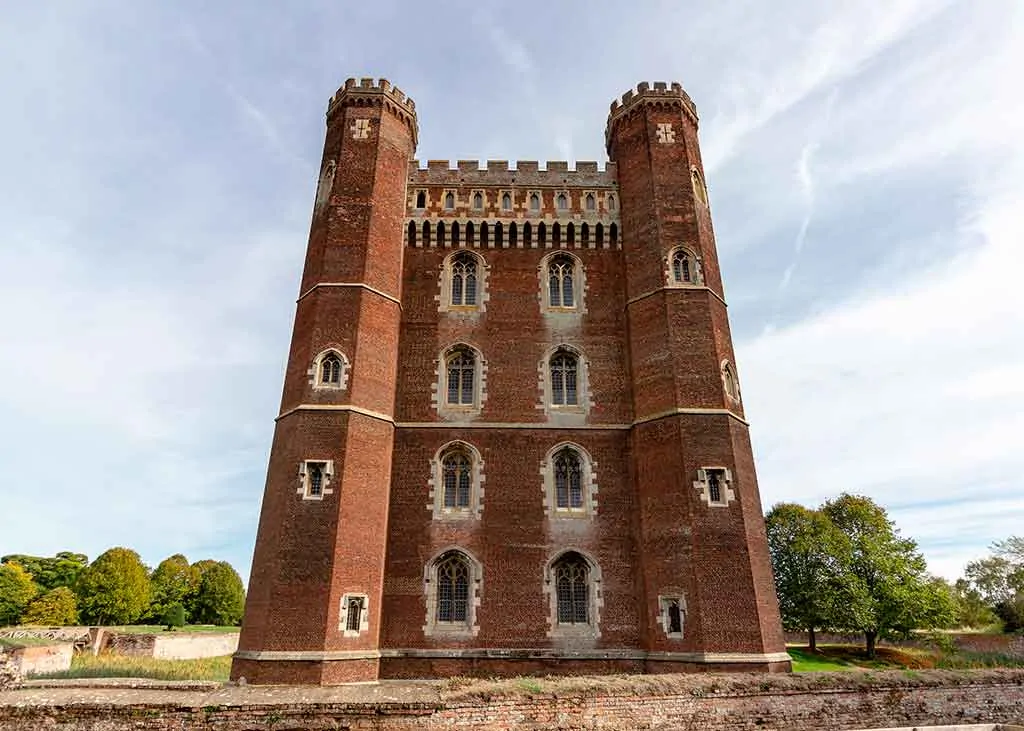
This beautiful red-brick moated castle was built by the treasurer of England, Lord Ralph Cromwell in 1231 as a way to show off his wealth and power and it still impresses to this day. Climb the tower, walk out onto the restored battlements to admire the view, and explore the chambers before exploring the gardens and grounds.
Where: Lincolnshire
When: 15th century
Style: Medieval
Open for visit: Yes. See the National Trust site for exact opening times.
26. Framlingham Castle

The curtain wall with 13 towers are all that remain of Framlingham Castle (aside from the Framlingham Workhouse visitors centre) but it’s still a breathtaking sight as you walk the 10.5 meter high ramparts and learn the history – It was at Framlingham Castle that Mary Tudor was proclaimed Queen of England.
Where: Suffolk
When: 12th century
Style: Norman
Open for visit: Yes. Check here for more information.
27. Windsor Castle
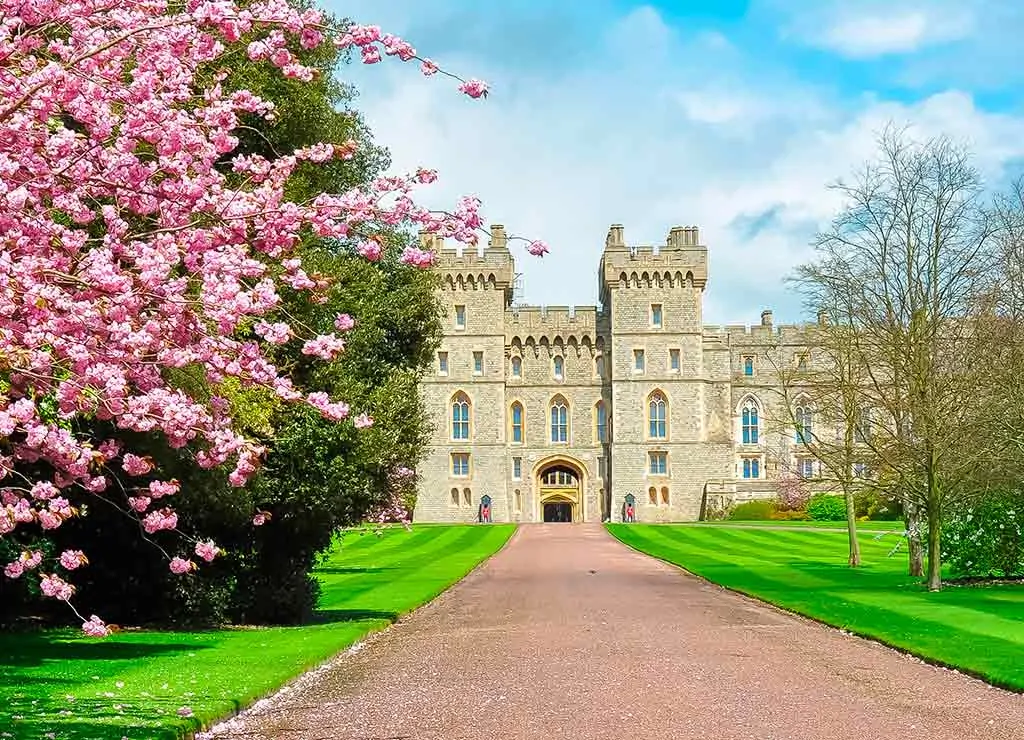
One of the Royal Residences of the Queen of England, Windsor Castle is the oldest and the largest occupied castle in the whole world. At 900 years old, it has been the home of 39 King’s and Queens of England including Henry VIII, Elizabeth I, and Queen Victoria who used Windsor as a full-time residence.
Where: Berkshire
When: 11th century
Style: Norman
Open for visit: Usually open daily but closures can happen at short notice – Check the website ahead of time for exact opening times.
28. St Michael’s Mount Castle
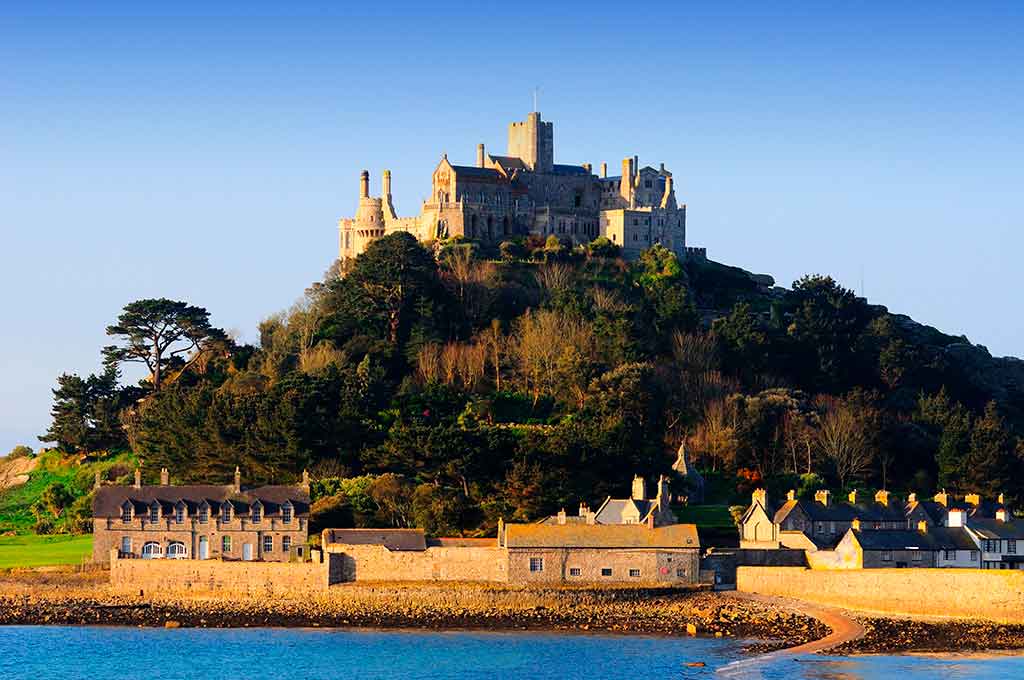
Admire the castle perched atop the mount as you cross the causeway at low tide before climbing up the cobbled paths leaving the harbor behind. Discover the history of the castle that’s been used as a priory, fort, and family home to the St Aubyn family.
Where: Cornwall
When: 12th century
Style: Medieval
Open for visit: Yes. Check here for more information.
29. Arundel Castle
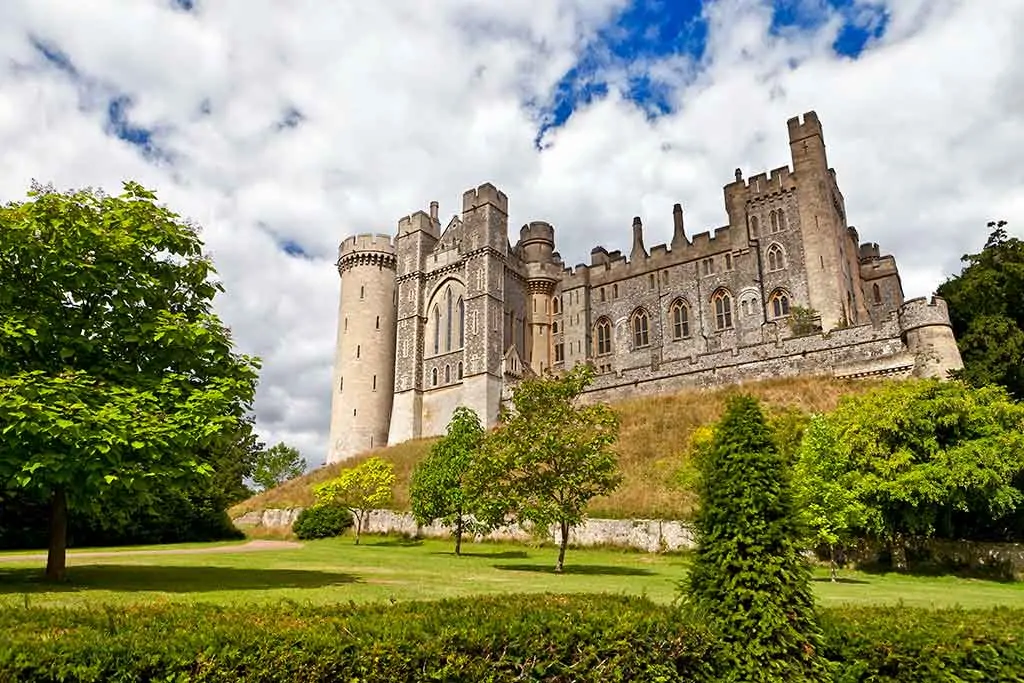
This restored Medieval castle and Gothic stately home retain many original features including the Medieval gatehouse, Norman Keep, and Barbican. Sitting atop a hill it has magnificent views out across the South Downs and River Arun.
Where: Sussex
When: 11th century
Style: Medieval / Gothic
Open for visit: Yes. Check here for more information.
30. Highcliffe Castle
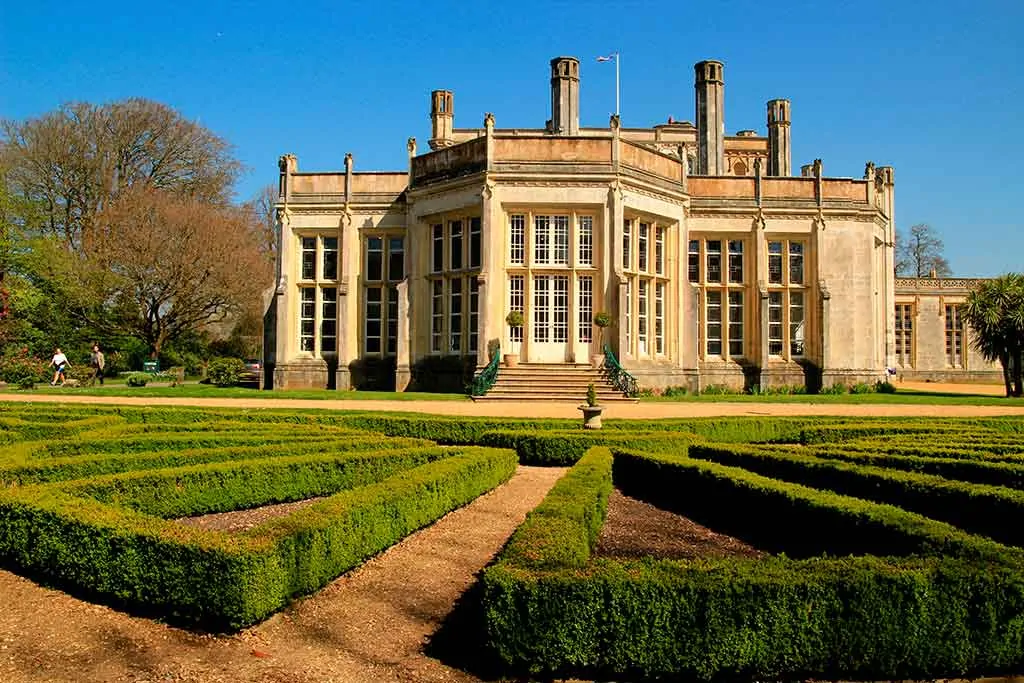
This Georgian clifftop mansion designed in the Gothic Revival style has gardens by Capability Brown and is said to be ‘the most important surviving house of the Romantic and Picturesque style of architecture’.
Where: Dorset
When: 18th century
Style: Gothic Revival
Open for visit: Yes. – Check the website for details.
Check out the best castles in Dorset.
31. Highclere Castle
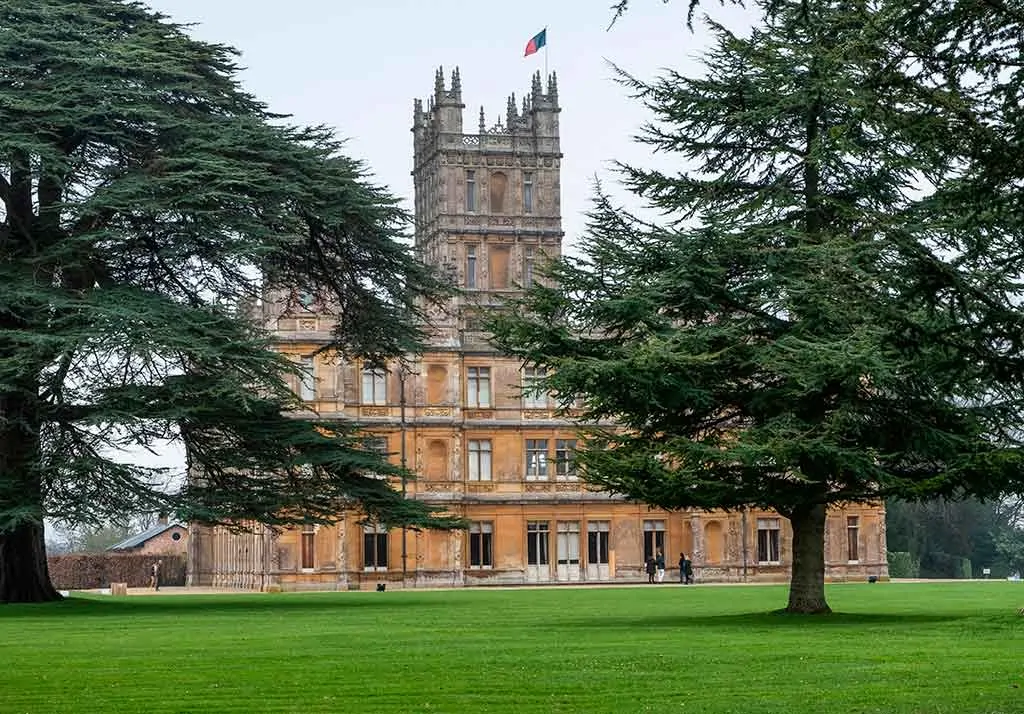
If you watched the TV show, Downton Abbey, you’ll be familiar with Highclere Castle. Visit the 5,000-acre estate to learn about the real family who lives at Highclere Castle on a guided tour of the interior as well as film set tours taking you through the staterooms shown in Downton Abbey.
Where: Hampshire
When: 17th century
Style: Jacobethan
Open for visit: Yes, selected dates only – See the website for details.
32. Tower of London
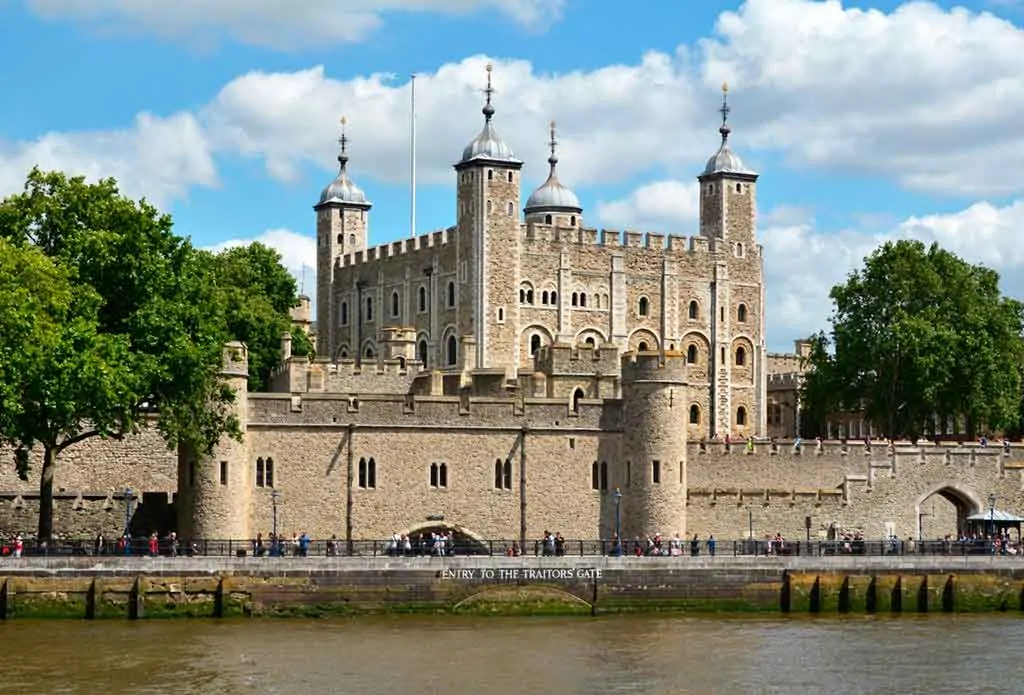
Used as a fort, palace, and prison, the iconic 1,000-year-old Tower of London has so much history to see not lest the crown jewels, and the ‘bloody tower’ where you’ll be led on a guided tour by the symbolic Beefeaters.
Where: London
When: 11th century
Style: Norman
Open for visit: Yes. Check here for more information.
33. Kenilworth Castle
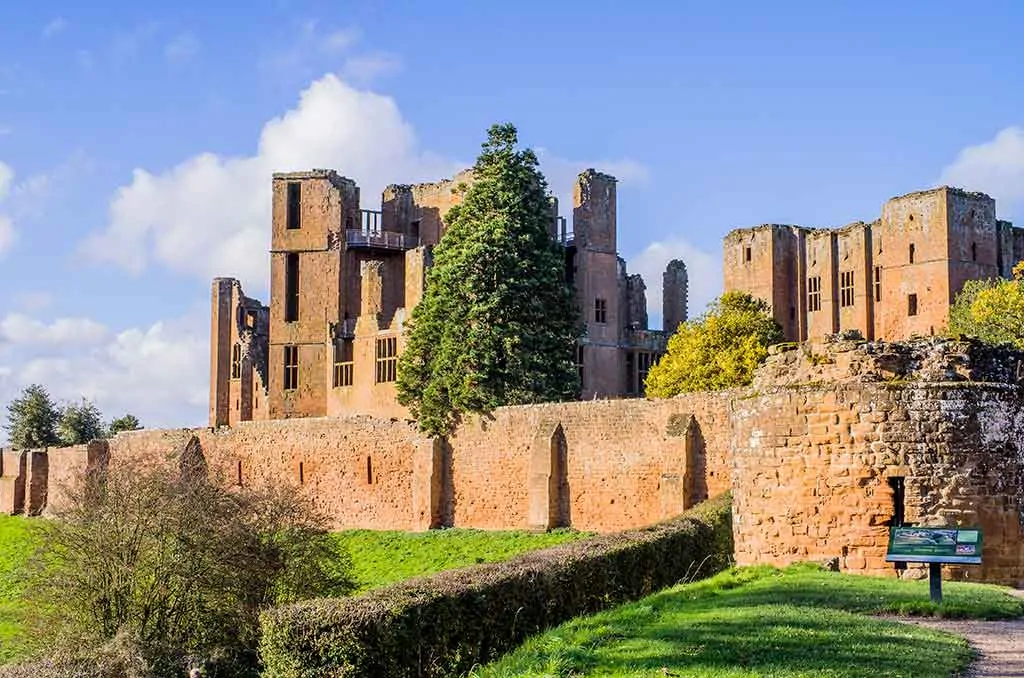
Starting out as a Medieval fortress, Kenilworth Castle later became an Elizabethan palace with a tower built especially for Elizabeth I. Explore 900 years of history inside and outside as you see the Norman keep, the gatehouse, the ruins of the great hall, and the Elizabethan garden.
Where: Warwickshire
When: 13th century
Style: Norman
Open for visit: Yes. Check here for more information.
34. Tintagel Castle

Stunning scenery, myths, legends, and history await you at Tintagel Castle that sits half on the mainland and half on the headland with the rugged Cornish coastline below. So cross the iconic bridge and learn the connection with King Arthur.
Where: Cornwall
When: 13th century
Style: Medieval
Open for visit: Yes, check here for more information.
35. Bolsover Castle

The Stuart mansion that is Bolsover Castle looks like it came straight out of a fairytale. See inside the rooms at the Little Castle, an extravagant retreat built for Sir William Cavendish, admire the views from the wall walk, and see the ruins of the Terrace Range.
Where: Derbyshire
When: 17th century
Style: Mock Medieval
Open for visit: Yes. Check here for more information.
You might also want to check out: The best castles in Derbyshire.
36. Portchester Castle
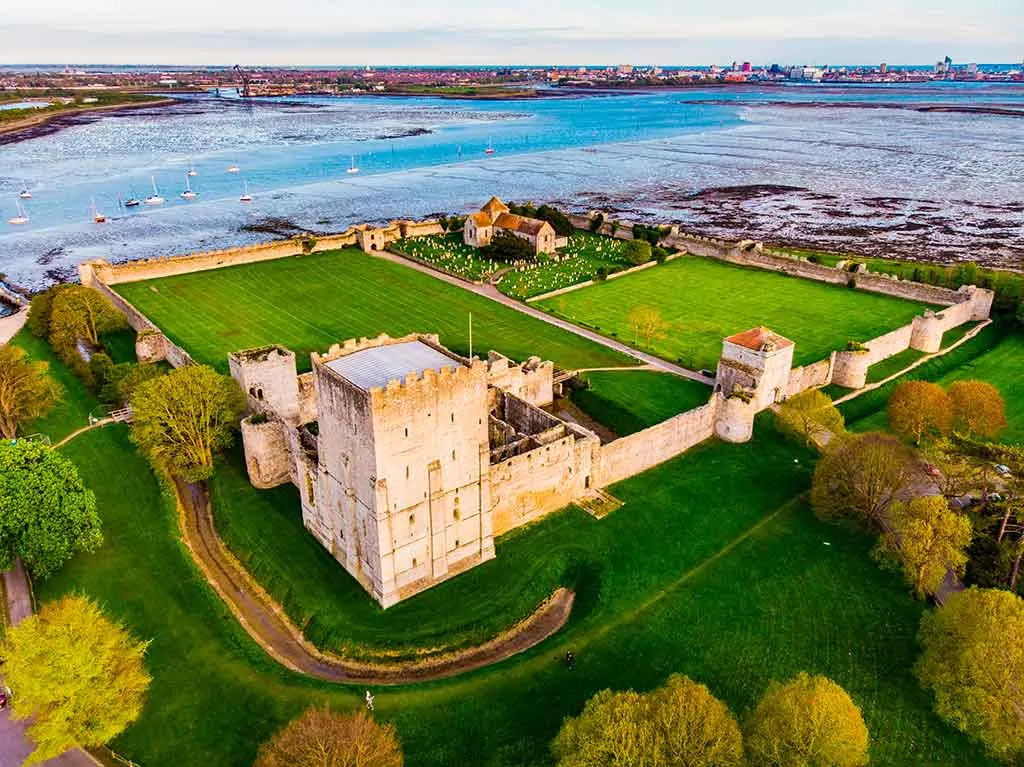
The best-preserved of all the Roman ‘Saxon Shore’ forts, Portchester Castle was a major defense for hundreds of years. Walk around the ruins, climb the spiral staircase, admire the views from the roof, and see the artefacts on display in the keep.
Where: Hampshire
When: 11th century
Style: Medieval
Open for visit: Yes. Check here for more information.
37. Beeston Castle
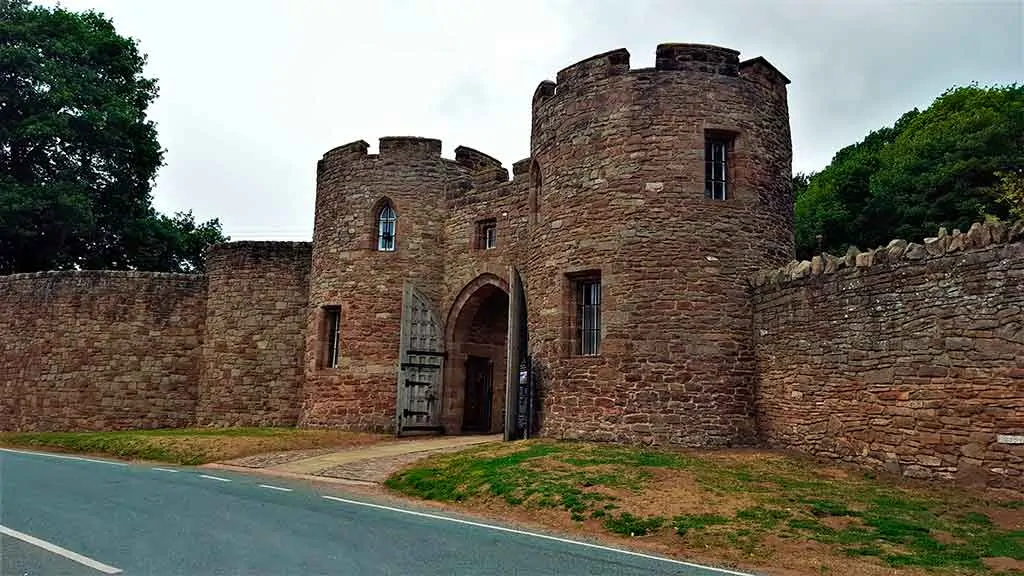
Visit the ruins of a former Royal castle perched on top of a 500-foot high cliff and admire the countryside views as you uncover 4,000 years of history on this site including the legend of Richard II’s lost treasure.
Where: Cheshire
When: 13th century
Style: Medieval
Open for visit: Yes. Check here for more information.
38. Middleham Castle
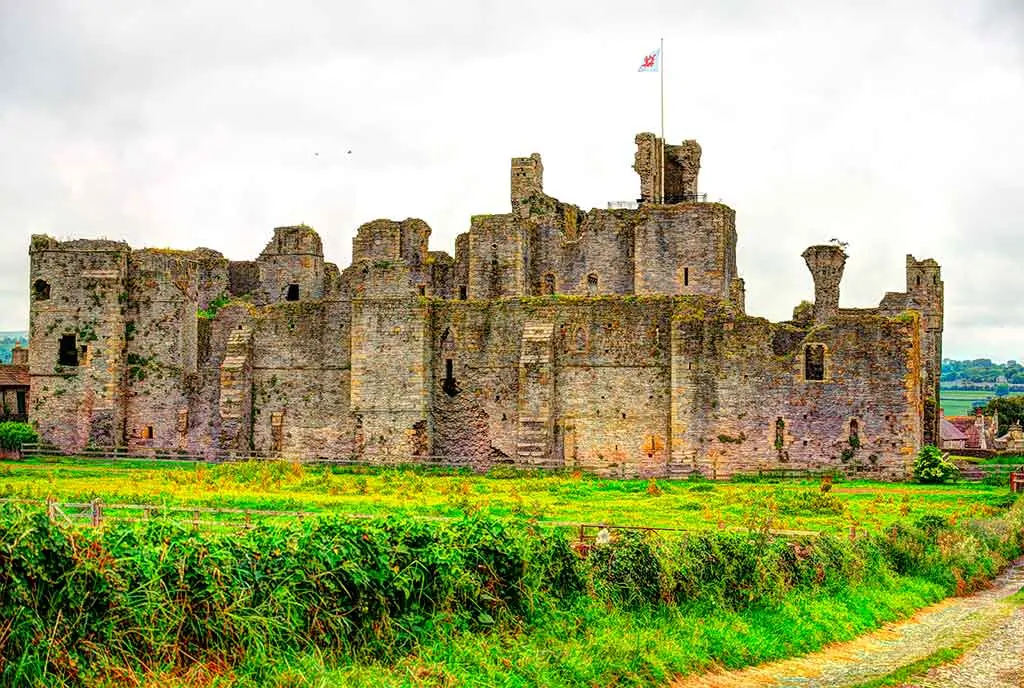
Step back in time as you explore the fortified ruins of Middleham Castle, the favored childhood home of King Richard III. Climb the steps of the keep to enjoy the view over the Yorkshire Dales, see the remains of the inner ward, and the curtain wall.
Where: Yorkshire
When: 14th century
Style: Medieval
Open for visit: Yes. Check here for more information.
39. Whittington Castle

This picturesque motte and bailey castle with moat now stands in ruin but can still be admired. Set in 12 acres of ground, take a walk or have a picnic as you admire the view, let the kids run off some energy, or join a guided walk to learn the history of Whittington Castle.
Where: Shropshire
When: 12th century
Style: Norman
Open for visit: Yes. Check here for more information.
40. Taunton Castle
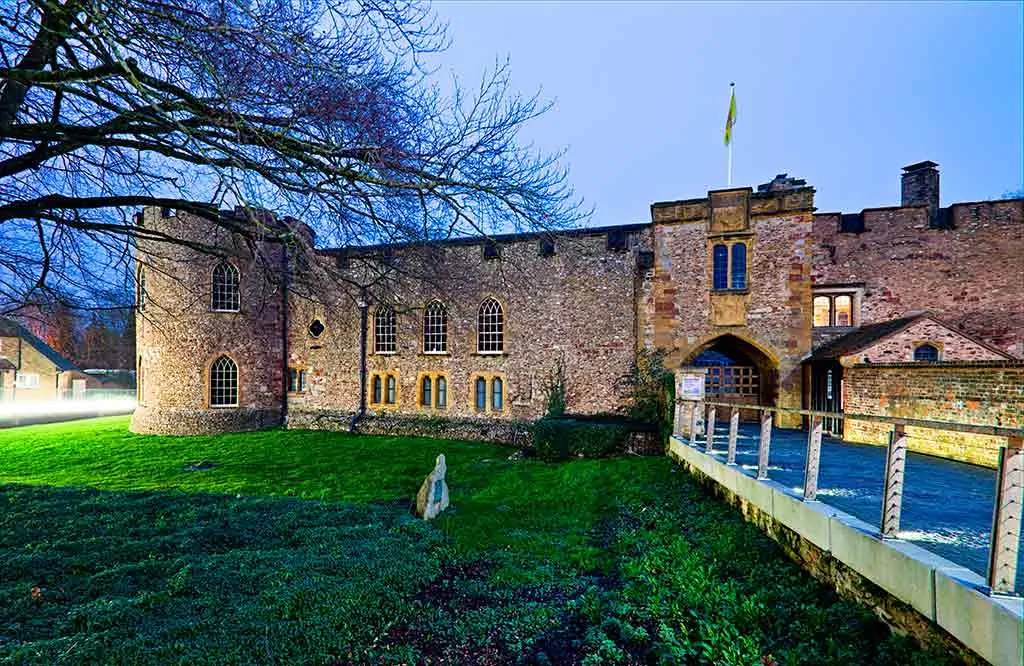
Located on an Anglo Saxon settlement, Taunton Castle is a motte and bailey castle with a tall 13th-century keep. Today, the castle houses the Museum of Somerset but in its time it has been an assize court, an assembly hall, and a prison.
Where: Somerset
When: 12th century
Style: Norman
Open for visit: Museum open. Check here for more information.
PIN IT!
